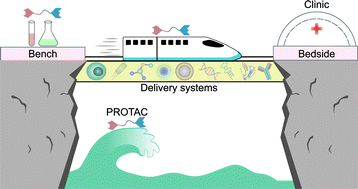Proteolysis-targeting chimera (PROTAC) delivery system: advancing protein degraders towards clinical translation
Abstract
Proteolysis Targeting Chimeras (PROTACs), an emerging therapeutic entity designed to degrade target proteins by hijacking the ubiquitin–proteasome system, have the potential to revolutionize the healthcare industry. The broad applicability of this protein degradation strategy has been verified with a few E3 ligases and a variety of distinct targets through the construction of modular chimeric structures. Despite recent efforts to promote the use of PROTACs for clinical applications, most PROTACs do not make it beyond the preclinical stage of drug development. There are several reasons that prevent PROTACs from reaching the market, and the inadequate delivery to the target site is one of the most challenging hurdles. With the increasing need for accelerating the translational process, combining the concepts of PROTACs and delivery systems has been explored to enhance the in vivo performance of PROTACs. These improved delivery strategies can eliminate unfavorable physicochemical properties of PROTACs, improve their targetability, and decrease their off-target side effects. The integration of powerful PROTACs and versatile delivery systems will inaugurate a burgeoning orientation for the field of targeted protein degradation. In this review, we will survey the latest progress in improving the in vivo degradation efficacy of PROTACs through delivery strategies, outline design principles for PROTAC-based delivery systems, discuss the current challenges with PROTACs, and outlook future opportunities in this field.



 Please wait while we load your content...
Please wait while we load your content...